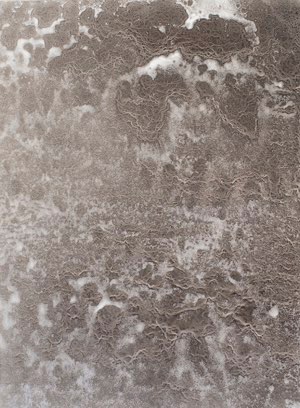Fanny Hellgren
Sediment drawing, 2020
Can the shore be considered a ruin? Billions of mineral fragments that once were part of mountains which at some point were shattered, carried and shaped by the waves, who knows for how long and from where, to gather at this site, becoming the shore. The geological time scale is so far from the human. The body of the stone is so different from my own. Still I can hold a stone in my hand and read its striped surface as a map of a dizzying time-lapse, millions of years compressed into thin layers.
If the shore in this sense is a ruin, can these drawings be defined similarly? As traces, more likely. I pour sand and water on the paper over and over again before I cover it with graphite powder and pigments. Once the water has evaporated I brush away the sand. What remains is the trace, as a recording of the event. Each grain of sand is like a microscopic island, surrounded by graphite crystals and water that have forced its way. The paper is a platform for the materials to interact and create temporary formations to be repeated eternally.
______
74 x 53 cm
Graphite and pigments on paper

